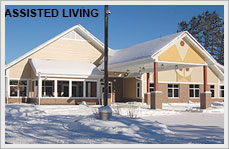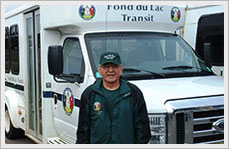
The Fond du Lac Natural Resources Program is responsible for the wild rice management and restoration activities. The primary method of wild rice lake management is by controlling water levels on the lakes by operating water control structures (dams), ditch maintenance, and beaver dam management. Two Technicians work full time on water level management and data collection. The Program Manager and the other technicians assist on these activities and also work on restoration planning and implementation.

Technicians are responsible for operation and maintenance of the “Cookie Cutter” (pictured above) or sedge mat cutter, two aquatic plant harvesters (pictured below), and two airboats which are used for vegetation removal and restoration of wild rice habitat.

Unfortunately, our wild rice watershed is not what it should be. In the early 1900’s a judicial ditch network was constructed with the intention of creating more agricultural area. The hydrologic alterations were not extremely successful at creating a large increase of agricultural area, areas that were wetlands simply became a little less wet. The impact to our wild rice resources was drastic. The ditching resulted in the loss of hundreds of acres of wild rice habitat. In a very short time it became apparent that productivity of wild rice was declining due to lower water levels. The lower water levels allowed competing vegetation such as cattails and other wetland vegetation to take over areas that once produced a healthy wild rice crop. As early as 1933, the state conservation staff noted a significant decline in wild rice and waterfowl production. Attempts were made by individuals and agencies to improve conditions for wild rice. Dams were built at Perch Lake and Rice Portage Lake, but by the 1980’s these structures were failing or nonexistent. FDL Natural Resources Program began an ambitious effort to find funding and construct the water control structures that are in place today.The construction of the dams was the first phase of a long-term project to restore wild rice production. The construction project was a massive undertaking because of permitting issues, surveying, permissions from state, county, federal agencies, individual landowners, allottees, etc. Thanks to the hard work of many people that still work for us, and others that have moved on, we have better control of water levels for the wild rice lakes.
The next phase of our restoration project was to remove competing vegetation. Through the generous support of the Fond du Lac Reservation, BIA Circle of Flight Program, and State Lottery Funds we have been able to purchase several pieces of specialized lake restoration equipment. The lead machine in this effort is the “Cookie Cutter” or sedge mat cutter. This barge with 5ft. props on the front does the rough cut, followed by our two aquatic plant harvesters which are outfitted with sickle bar cutters and conveyor belts to clean up after the “Cookie Cutter”. After areas are cut and harvested they are reseeded with wild rice obtained from harvesters in the fall. This effort has been extremely successful so far, but hundreds of acres remain.
There are five primary wild rice lakes on the Fond du Lac Reservation. The total area on which wild rice is currently present on these lakes is 832 acres.
Rice Portage Lake
The drainage of this lake since 1922 resulted in the reduction of the original 634 acre lake to only about 114 acres of open water, on which wild rice could grow. The remainder of the lake bottom was exposed or very shallow and competing vegetation grew on these areas. The hundreds of acres of floating cattail mats, sedges, and other competing plants on Rice Portage will be cut up with the Reservation’s “Cookie Cutter”, and collected and removed with the aquatic plant harvesters. Some reclaimed areas will be seeded to enhance wild rice growth. The restored areas are monitored, mapped, and assessed each year. So far we have succeeded in restoring approximately 30 acres on Rice Portage Lake. We have identified another 150 plus acres for restoration.
Perch Lake
Perch Lake had abundant wild rice stands for many years. About 385 acres of this 657 acre lake had extensive wild rice stands. This lake was not as severely impacted by the drainage ditch system as most of the other wild rice lakes. A concrete dam was constructed on the Lake outlet in 1936, however it was not functional by the 1960’s after decades of deterioration. For several decades pickerel weed (Pontedaria cordata), a.k.a.: pickerel weed or “moose-ear” colonized this wild rice lake and displaced many acres of productive wild rice stands. Past plans to uproot this nuisance weed with the “Cookie Cutter” and collect and remove the plants and root materials with the aquatic plant harvesters have been fairly successful. To date we have been able to restore wild rice to over 200 acres where pickerel weed was the dominant vegetation. Complete eradication of competing vegetation is unlikely, so ongoing maintenance cutting will be necessary. Regular monitoring, mapping, and assessments of this project are conducted.
Jaskari Lake
This 79 acre wild rice lake is located downstream of Perch Lake, however it is also plagued by the colonization of pickerel weed. Current plans are to remove this problem weed with the same methods used on Perch Lake. In order to get our restoration equipment onto the lake, a heavy duty equipment access is needed. The construction of the access is currently being engineered and planned. Once access is available approximately 15 acres of wild rice habitat can be restored.
Deadfish Lake
The wild rice stands on this 71 acre lake were commonly flooded and destroyed because of the ditch system. Deadfish Lake has a large watershed and ditching allowed the summer rains to flow rapidly into the lake. The drainage ditches also lowered the lake elevation, which aggravated this flooding problem. The newly constructed impoundment upstream of Deadfish Lake helps prevent flooding. The outlet dam allows for moderating lake level fluctuations and controlling the release of water from the lake.
Mud Lake
This wild rice lake is located on a side channel of the ditch system, upstream of Rice Portage Lake. The 141 acre lake can have abundant wild rice stands, however, the ditched outlet is an ongoing management problem. Lower water levels have allowed competing vegetation to encroach on wild rice habitat.
Wild Rice Lake
This 54 acre wild rice lake has not supported a viable wild rice crop for decades, due to high water levels caused by beaver dams under Highway 210 and downstream. By cooperating with FDL Environmental Program, FDL Wildlife, Minnesota DNR, and Ducks Unlimited we have been able to install two “Beaver Deceivers” or pond levelers, trap nuisance beavers, remove dams, and reseed the lake. This is an ongoing project and it may take several years of seeding and maintenance to produce wild rice stands that can sustain harvest.








